Research
Aqua Planetology

High resolution and dense datasets of Martian surface has raised an issue; is current Martian cryosphere local or global? Trying to solve this issue, we are surveying underground structure using subsurface radar data.
Origin of water on Mars
The sculpted channels of the Martian southern hemisphere speak loudly of flowing water, but this terrain is ancient. Consequently, planetary scientists often describe early Mars as ‘warm and wet’ and current Mars as ‘cold and dry’. However, despite its crucial role in biological and geological processes, information about water on Mars is still controversial.
We (Tomohiro Usui and his collaborators at NASA’s Johnson Space Center and Carnegie Institute of Washington) report on geochemical studies that help towards settling the controversy that surrounds the origin, abundance, and history of water on Mars. The team reveals the micro-distribution of hydrogen isotopes recorded in Martian meteorites; hydrogen is the major component of water and it isotopes (H and Deuterium) are good indicators to trace the history of water. We report definitive evidence that the Martian mantle has retained a primordial hydrogen isotope composition similar to water on Earth but distinct from the water in the present Martian atmosphere.
These observations suggest that Mars and Earth should have similar water sources probably originated from the Main-belt asteroids, and that Mars should have experienced significant atmospheric loss through the history, which induced the climate change from ‘warm and wet’ to ‘cold and dry’.
More information: [NASA Press release on November 19, 2012]
Evolution of surface water on Mars
Martian surface morphology implies that Mars was once warm enough to maintain persistent liquid water on its surface. While the high D/H ratios (~5000 per mil) of the current martian atmosphere suggest that significant water has been lost from the surface during the martian history, the timing, the processes, and the amount of the water loss have been poorly constrained. Recent technical developments of ion-microprobe analysis of Martian meteorites have provided accurate estimation of hydrogen isotope compositions (D/H) of Martian water reservoirs at the time when the meteorites formed. Based on the D/H datasets from Martian meteorites, we estimate the amounts of water loss due to atmospheric escape and demonstrate that water loss during pre-Noachian was more significant than in the rest of the martian history. Combining our results with geological and geomorphological evidence for ancient oceans, we propose a possibility that there should be undetected subsurface water/ice of much greater extent than the collective amounts of “visible” current water inventory. Our study further implies that, because such large water inventory automatically calls for significant water loss that cannot be explained by oxygen escape models, unknown mechanisms that effectively consume the remaining excess oxygen should be required.
More information: [Inside Science on May23, 2015]
Evidence of subsurface water on Mars
The surface geology and geomorphology of Mars indicates that it was once warm enough to maintain a large body of liquid water on its surface, though such a warm environment might have been transient. The transition to the present cold and dry Mars is closely linked to the history of surface water, yet the evolution of surficial water is poorly constrained.
We have conducted in situ hydrogen isotope (D/H) analyses of quenched and impact glasses in three Martian meteorites (Yamato 980459, EETA79001, LAR 06319). The hydrogen isotope analyses provide evidence for the existence of a distinct but ubiquitous water/ice reservoir (D/H = 2–3 times Earth’s ocean water: SMOW) that lasted from at least the time when the meteorites crystallized (173–472 Ma) to the time they were ejected by impacts (0.7–3.3 Ma), but possibly much longer. The origin of this reservoir appears to predate the current Martian atmospheric water (D/H = ~5–6×SMOW) and is unlikely to be a simple mixture of atmospheric and primordial water retained in the Martian mantle (D/H ≈SMOW). Given the fact that this intermediate-D/H reservoir (2–3×SMOW) is observed in a diverse range of Martian materials with different ages (SNC meteorites, ALH 84001, Curiosity surface data), we conclude that this intermediate-D/H reservoir is likely a global surficial feature that has remained relatively intact over geologic time. We propose that this reservoir represents either hydrated crust and/or ground ice interbedded within sediments. Our results corroborate the hypothesis that a buried cryosphere accounts for a large part of the initial water budget of Mars.
More information: [NASA Press release on December 18, 2014]
Small body exploration and sample analysis
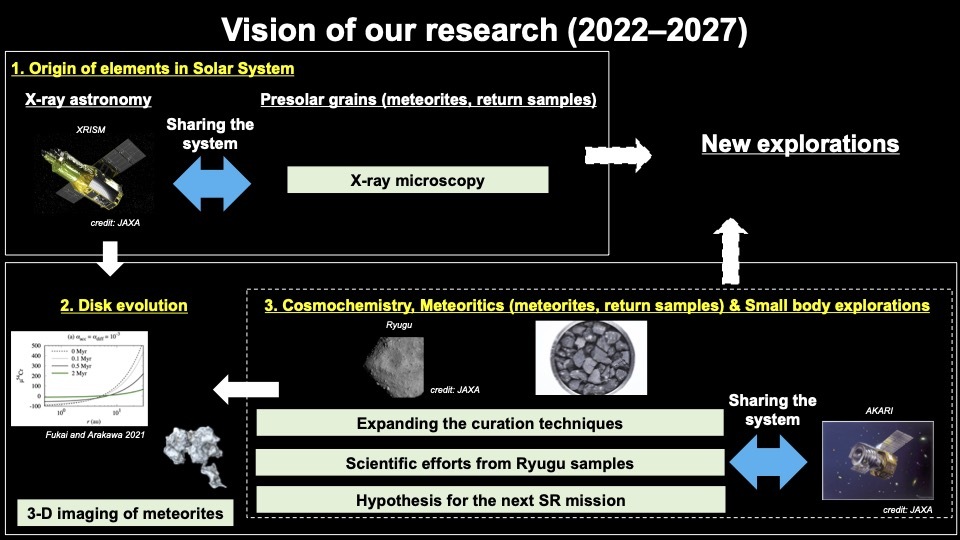
We investigate the origin of Solar System, using the petrological, morphilogical, and chemical data for the return samples and meteorites.
1: Origin of elements in Solar System
The elements in the Solar System have been formed by the various types of nucleosynthesis. The elements heavier than iron (Fe) are generally synthesized in the final stage of the stellar evolution. Primitive meteorites (chondrites) possess the tiny grains (presolar grains) formed in those stellar environments, which preserved the nucleosynthetic events.
We are developing the spectroscopic techniques for measuring the trace elements in the presolar grains by STEM-EDS system.
2: Disk evolution in the early Solar System
The presolar grains (mentioned above) were incorporated to the molecular cloud core. In the early Solar System, the gas disk was formed after the collapse of the molecular cloud core. The planetary formation models predected that transporation, mixing, and fragmentation of the particles were occurred within disk.
To confirm these events from the sample analysis, we are developing the bright-field image 3D tomography and analyzing the meteorites. We compare these data to X-ray elemental data obtained by electron microscopes (SEM and EPMA).
More information for instruments: [ASRG instrument]
3: Asteroid (return sample) – meteorite connection: What's next?
The planetesimals (major sources for solid planets) were formed via the coagulation of dust in the disk. Some types of primitive asteroids are considered as the remnant of the planetesimals. The environment and process of planetesimal formation is the key for the planet formation models. In order to contrain the models, spectroscopic observation of asteroids is the powerful tool, however, we should consider the space weathering effects on the surface of asteroids. Simiraly, the terrestrial contamination is critical for the sample analysis.
To assess the relationship between asteroid and meteorite, we investigate the primitive meteorite as the analogs with the infrared spectroscopy (FT-IR), high-resolution bright-field images, and the electron microscopes (SEM and EPMA). We are also developing the mass spectrometry techniques to measure the elemental abundances of asteroid samples.
More information for instruments: [ASRG instrument]
4: Asteroid (return sample) – thermal properties
It has been revealed that the return samples brought back from Ryugu and Bennu are extremely primordial materials that have not undergone alteration since the early formation of the Solar System. Therefore, by understanding the thermal properties of the return samples (such as thermal conductivity, thermal inertia, thermal diffusivity, specific heat, etc.), it is possible to obtain important information for clarifying the thermal environmental conditions of the evolutionary process of Ryugu and Bennu's parent celestial bodies. However, due to the limited quantity of return samples, conventional thermal property measurements involving sample processing and contamination could not be carried out. To address this, we are developing a method to measure the thermal diffusivity of return samples non-destructively and without contamination using laser and lock-in thermography, and we are conducting research to elucidate the formation processes of celestial bodies in the early Solar System from the perspective of the thermal properties of the return samples. Furthermore, in order to elucidate the thermal properties of today’s asteroids, which are essential not only for studying the asteroid formation process, but also for planetary defense research, we are assessing the relationship between the thermal properties of return samples and those obtained from remote sensing of asteroids. It is actually known that the thermal inertia of return samples does not match with that by remote sensing, and we are working on understanding the reasons for this discrepancy.
More information: [Ishizaki et al. (2023)]
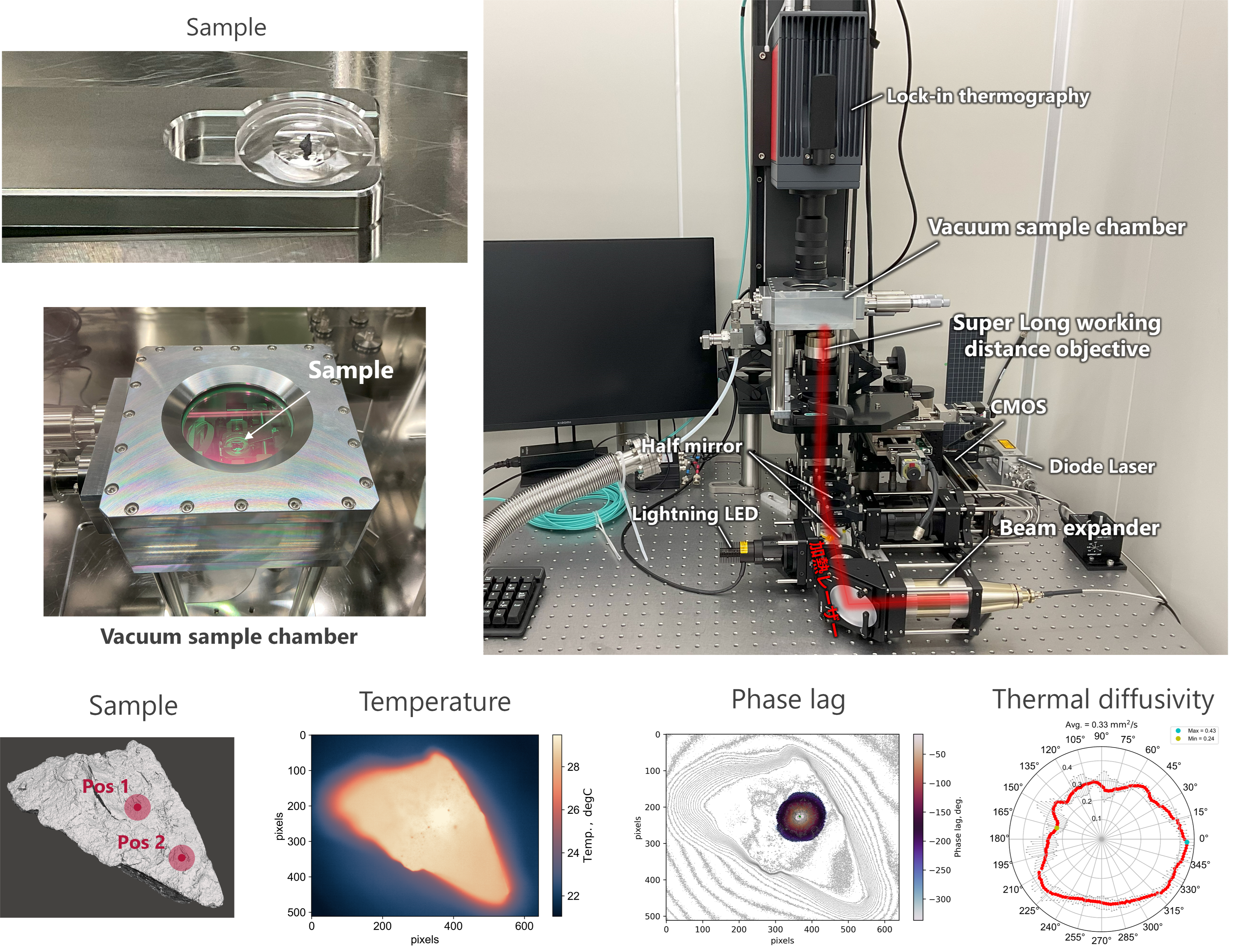
Fieldwork
Jogashima Field Trip
On June 5th, members of the Solid Earth Group went on a field trip to Jogashima, Kanagawa. This area consists of an accretionary complex formed by the subduction of the Philippine Sea Plate beneath the Japanese Islands, along with overlying sedimentary rocks. Because these geological structures are exceptionally well exposed, Jogashima is widely known as a classic site for field excursions. Through this field trip, we were able to gain a more concrete understanding of geological features that are often only accessible through planetary exploration data.

Group photo at Umano-Se-Domon, Jogashima. (Image credit: Kohji Takimoto)
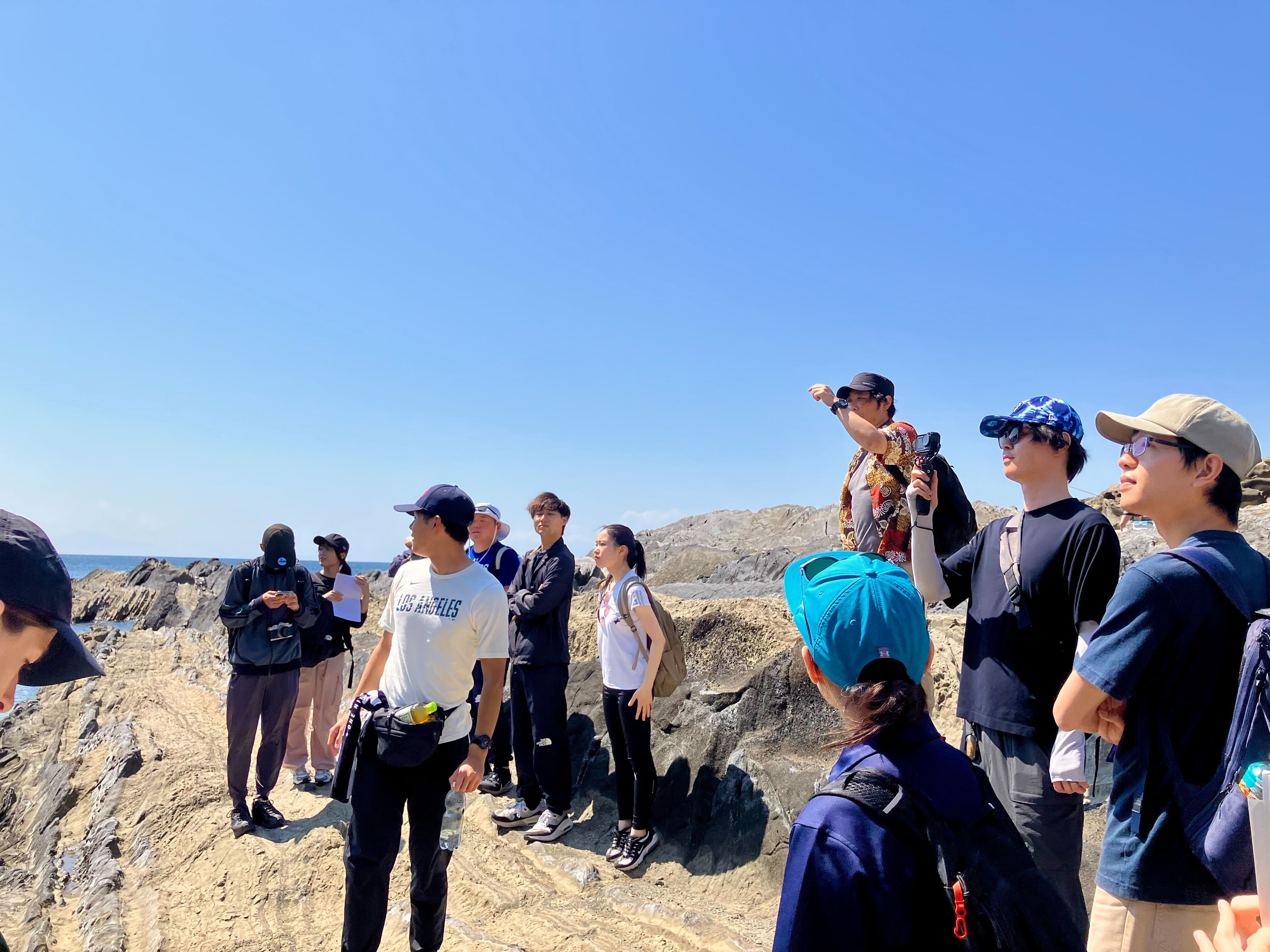
Observing the strike and dip of strata invites reflection on the dynamic forces of plate tectonics. (Image credit: Kantaro Shoji)
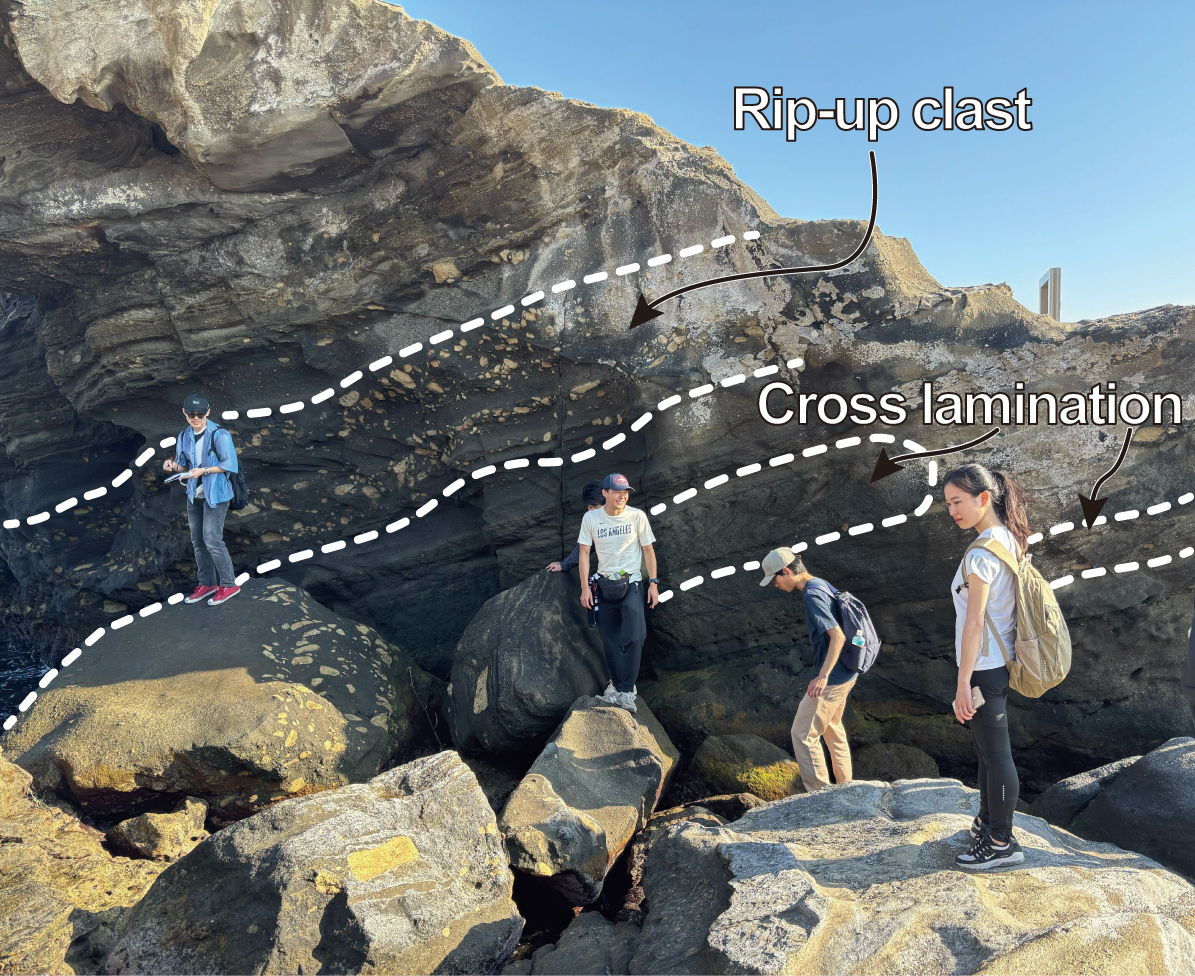
In front of striking features like cross-lamination and rip-up clasts, we closely examined the geological structures. (Image credit: Satoshi Yoshida)
Horomon Field Trip
Usui and Hirata joined the field trip at Horoman, Hokkaido from the 16th to the 19th of August. This area is famous for peridotite exposure, which originates from the Earth’s mantle.
1st day, was about the petrological and structural study of the peridotite, displayed in front of the town office. On the 2nd and 3rd days, fieldwork was carried out in and around outcrops of Mt. Apoi and the Horoman River to understand the change of the lithology with topography.
Students and researchers from various universities also joined in that field trip. Dr. Tomoaki Morishita from Kanazawa University shared his knowledge about the basics of the geology of the region, the origin of peridotite, and so on. Also, it was a precious experience for all the members where everyone exchanged their research topics and idea with researchers from different fields.
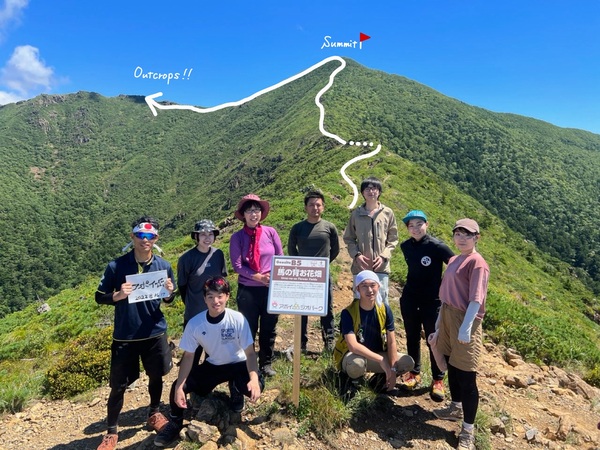
Group photo at Mt. Apoi. The group reached the outcrop passing through the summit (white arrow in the picture). (Image credit: Kaori Hirata)

Hirata closely looked at the rocks beside the Horoman River. Everyone was very careful so that no one slips down to the river. (Image credit: Kaori Hirata)

In the afternoon of the 3rd day, Prof. Usui presented his research at the lodge, as everyone had to return early due to the bad weather. (Image credit: Kaori Hirata)
Missions
MMX
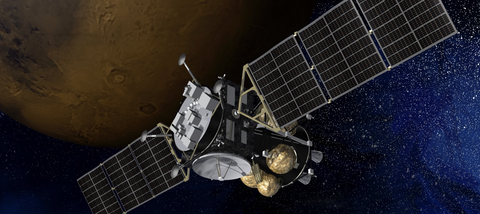
Martian Moons eXploration (MMX); a sample-return mission to clarify the origin of Mars and Martian moons, Phobos and Deimos. (Image credit: JAXA)
The big picture of MMX is to understand the origin and evolution process of our habitable solar system.
The targets of MMX, Phobos and Deimos, are possibly formed by (i) a captured asteroid after Mars formation, or (ii)
scattered fragments made by a giant impact. The formation process will be determined after moon observations and
returned sample analyses.
MMX will also reveal the mechanism of atmospheric material circulation and dispersion based on observation results of
Mars and its surrounding space from the vicinity of Martian moon.
Martian materials on Phobos

It is indicated that small impacts on Mars throughout its history delivered impact ejecta from Mars to Phobos and Deimos.
Recent study shows that the total amount of the delivery of Mars ejecta to Phobos and Deimos is 10-100 times larger than previously estimated and Mars ejecta mixed in the regolith of its moons potentially covers all its geological eras and consists of all types of rocks, from sedimentary to igneous.
MMX would sample such diverse Mars materials back to the Earth.
The study of the moons opens the door to looking at more than individual objects but at the Mars System Science.
(Member: Tomohiro Usui, Ryuki Hyodo)
Origin of Phobos and Deimos
The one of main objective of MMX is to investigate whether the Martian moons are captured asteroids or fragments that coalesced after a giant impact with Mars. MEGANE (gamma-ray spectrometer on MMX) will reveal the elemental compositions of bulk Phobos, which helps us understand Phobos's origin. Also, the isotopic analysis for return samples will give a strong constraint. We are preparing the analytical protocols for return sample, and investigating the capability of MEGANE by parameter study.
(Member: Tomohiro Usui, Kaori Hirata, Ryuki Hyodo, Haruna Sugahara, Ryota Fukai, and Yuki Uchida)
Hayabusa2
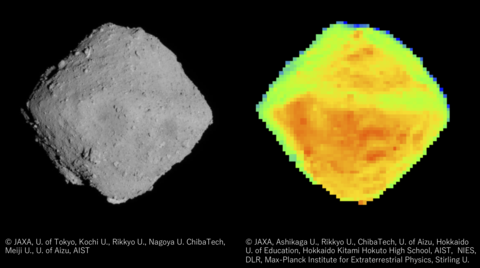
Hayabusa2 spacecraft explored the C-type asteroid Ryugu, which is expected to contain water and organics as building blocks of the Earth. Hayabusa2 mission aims to reveal the origin of the primitive asteroid, oceans on the Earth, and where do we come from.
Curation and initial analyses of Hayabusa-2 samples
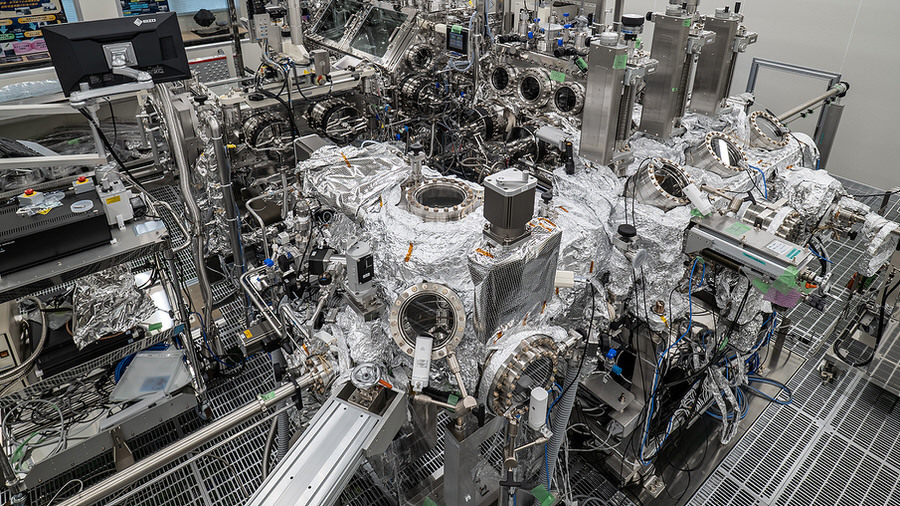
The samples from C-type asteroid Ryugu was returned to ISAS on December 2020. We manage the chamber dedicated to Ryugu samples including infrared hyperspectral microscope (MicrOmega). After the initial description and characterization of samples, we have started to conduct the analyses consisted with the detailed petrologic observation, spectral measurements, and inorganic and organic chemical measurements etc.
(Member: Tomohiro Usui, Ryota Fukai, and Haruna Sugahara)